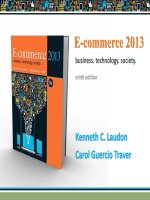Lecture E-commerce (7/e): Chapter 11 - Kenneth C. Laudon, Carol Guercio Traver
Bạn đang xem bản rút gọn của tài liệu. Xem và tải ngay bản đầy đủ của tài liệu tại đây (807.74 KB, 35 trang )
Ecommerce: Business. Technology.
Society.
Ecommerce
business. technology. society.
seventh
edition
Kenneth C.
Laudon
Copyright © 2011
Pearson Education,
Inc.
Copyright © 2011 Pearson Education, Inc.
Carol Guercio
Traver
Chapter 11: Social Networks, Auctions,
and Portals
Chapter 11
Social Networks, Auctions, and
Portals
Copyright © 2011 Pearson Education, Inc.
Copyright © 2011 Pearson Education, Inc.
Copyright © 2010 Pearson Education, Inc.
Slide 112
Social Network Fever
Spreads to the Professions
Class Discussion
How has the growth of social networks enabled
the creation of more specific niche sites?
What are some examples of social network sites
with a financial or business focus?
Describe some common features and activities
on these social network sites.
What features of social networks best explain
their popularity?
Copyright © 2011 Pearson Education, Inc.
Slide 113
Social Networks and Online Communities
Internet began as community building
technology for scientists, researchers
Early communities limited to bulletin boards,
newsgroups; e.g. the Well
2002: Mobile Internet devices, blogs, sharing of
rich media began new era of social networks
Social networks one of most common Internet
activities
Copyright © 2011 Pearson Education, Inc.
Slide 114
What Is an Online Social Network?
Online
area where people who share
common ties can interact
Participants do not necessarily share
goals
Portals and social networks:
Moving
closer together
Portals adding social network features
Community sites adding portal-like services
Searching
News
E-commerce services
Copyright © 2011 Pearson Education, Inc.
Slide 115
The Growth of Social Networks and
Online Communities
Top 10 social networks account for over 90%
social networking activity
Facebook users: Over 54% are 35+
Unique audience size:
Social networks: 175 million
Top 4 search engines: 510 million
Annual advertising revenue
Social network sites: $1.6 billion
Top 4 search engines: $14 billion
Copyright © 2011 Pearson Education, Inc.
Slide 116
Top 10 Social Network Sites, 2010
Figure 11.1, Page 714
Copyright © 2011 Pearson Education, Inc.
SOURCES: Based on data from eMarketer, 2010; Hitwise,
2010
Slide 117
Types of Social Networks
and Their Business Models
Early social network sites relied on subscriptions
Today primarily advertising
General communities:
Offer opportunities to interact with general audience organized
into general topics
Advertising supported by selling ad space on pages and videos
Practice networks:
Offer focused discussion groups, help and knowledge related to
area of shared practice
May be profit or non-profit; rely on advertising or user donations
Copyright © 2011 Pearson Education, Inc.
Slide 118
Types of Social Networks
and Their Business Models (cont’d)
Interest-based social networks:
Affinity communities:
Offer focused discussion groups based on shared interest in
some specific subject
Usually advertising supported
Offer focused discussion and interaction with other people who
share same affinity (self or group identification)
Advertising and revenues from sales of products
Sponsored communities:
Created by government, non-profit or for-profit organizations for
purpose of pursuing organizational goals
Copyright © 2011 Pearson Education, Inc.
Slide 119
Social Network Features
and Technologies
Profiles
Instant messaging
Friends network
Message boards
Network discovery
Online polling
Games, widgets,
apps
Chat
Discussion groups
Experts online
Membership
management tools
Favorites
Copyright
© 2011
Storage
Pearson
Education,
Inc.
Slide 1110
Insight on Technology
Social Operating Systems:
Facebook vs. Google
Class Discussion
What does Mark Zuckerberg, Facebook’s CEO,
mean by “social operating system?”
Why have Facebook applications become so
popular? Do they have any limitations?
How has Google responded? Which core
functions can their programs perform?
What are the advantages of Google’s software
over “closed worlds” like Facebook?
Copyright © 2011 Pearson Education, Inc.
Slide 1111
Online Auctions
Online
auction sites among the most
popular consumer-to-consumer sites on
the Internet
eBay:
Market leader
Several
hundred different auction sites in
U.S. alone
Established
portals and online retail sites
increasingly are adding auctions to their
Copyright © 2011 Pearson Education, Inc.
Slide 1112
Defining and Measuring the Growth of
Auctions and Dynamic Pricing
Dynamic
pricing
Airline
tickets, coupons, college scholarships
Prices based on demand characteristics of customer
and supply situation of seller
Many
types of dynamic pricing
Bundling
Trigger
pricing
Utilization pricing
Personalization pricing
Copyright © 2011 Pearson Education, Inc.
Slide 1113
Defining and Measuring the Growth of
Auctions and Dynamic Pricing (cont’d)
Auctions:
C2C
Type of dynamic pricing
auctions
Auction
house an intermediary
$25 billion gross revenue 2009
B2C
auctions
Business
owns assets; often used for excess
goods
$19 billion gross revenue 2009
Can
be used to allocate, bundle resources
Expected to grow 5% -10% annually through
Copyright © 2011 Pearson Education, Inc.
Slide 1114
Benefits of Auctions
Liquidity
Price discovery
Price transparency
Market efficiency
Lower transaction costs
Consumer aggregation
Network effects
Market maker benefits
No
inventory or fulfillment activities
Copyright © 2011 Pearson Education, Inc.
Slide 1115
Risks and Costs of Auctions for
Consumers and Businesses
Delayed consumption costs
Monitoring costs
Fixed pricing
Watch lists
Proxy bidding
Equipment costs
Trust risks
Possible solutions include:
Possible solution—rating systems
Fulfillment costs
Copyright © 2011 Pearson Education, Inc.
Slide 1116
Internet Auction Basics
Different
Last
from traditional auctions
much longer (usually a week)
Variable
number of bidders who come and go from
auction arena
Market
power and bias in dynamically
priced markets
Neutral:
Number of buyers and sellers is few or equal
Seller
bias: Few sellers and many buyers
Buyer
bias: Many sellers and few buyers
Copyright © 2011 Pearson Education, Inc.
Slide 1117
Internet Auction Basics (cont’d)
Price Allocation
Rules
Uniform
pricing rule: Multiple winners who all
pay the same price
Discriminatory pricing rule: Winners pay
different amount depending on what they bid
Public
vs. private information
Prices
Bid
Open
bid may be kept secret
rigging
markets
Price
matching
Copyright © 2011 Pearson Education, Inc.
Slide 1118
Bias in Dynamically Priced Markets
Figure 11.4, Page 727
Copyright © 2011 Pearson Education, Inc.
Slide 1119
Types of Auctions
English
auctions:
Single
item up for sale to single seller
Highest bidder wins
Traditional
Dutch auction:
Uses
a clock that displays starting price
Clock ticks down price until buyer stops it
Dutch
Internet auction:
Public
ascending price, multiple units
Final price is lowest successful bid, which sets price
for all higher bidders
Copyright © 2011 Pearson Education, Inc.
Slide 1120
Types of Auctions (cont’d)
Name
Your Own Price Auctions
Users
specify what they are willing to pay for goods or
services and multiple providers bid for their business
Prices do not descend and are fixed
Group
buying auctions (demand
aggregators)
Group
buying of products at dynamically adjusted
discount prices based on high volume purchases
Two principles
Sellers more likely to offer discounts to buyers purchasing in
volume
Buyers increase their purchases as prices fall
Copyright © 2011 Pearson Education, Inc.
Slide 1121
Types of Auctions (cont’d)
Professional
Example:
Auction
service auctions
Elance.com
aggregators (mega auctions)
Use
Web crawlers to search thousands of
Web auction sites and accumulate information
on products, bids, auction duration, etc.
Unlicensed
aggregators opposed by eBay
Copyright © 2011 Pearson Education, Inc.
Slide 1122
Copyright © 2011
Pearson
Education,
Table 11.7, p 733
Inc.
Slide 1123
Seller and Consumer Behavior
at Auctions
Seller profit: Arrival rate, auction length, and
number of units at auction
Auction prices not necessarily the lowest
Unintended results of participating in auctions:
Winner’s
regret
Seller’s lament
Loser’s lament
Consumer trust an important motivating factor in
auctions
Copyright © 2011 Pearson Education, Inc.
Slide 1124
Auction Profits
Figure 11.5, Page 744
Copyright © 2011 Pearson Education, Inc.
SOURCE: Vakrat and Seidmann,
1998.
Slide 1125









